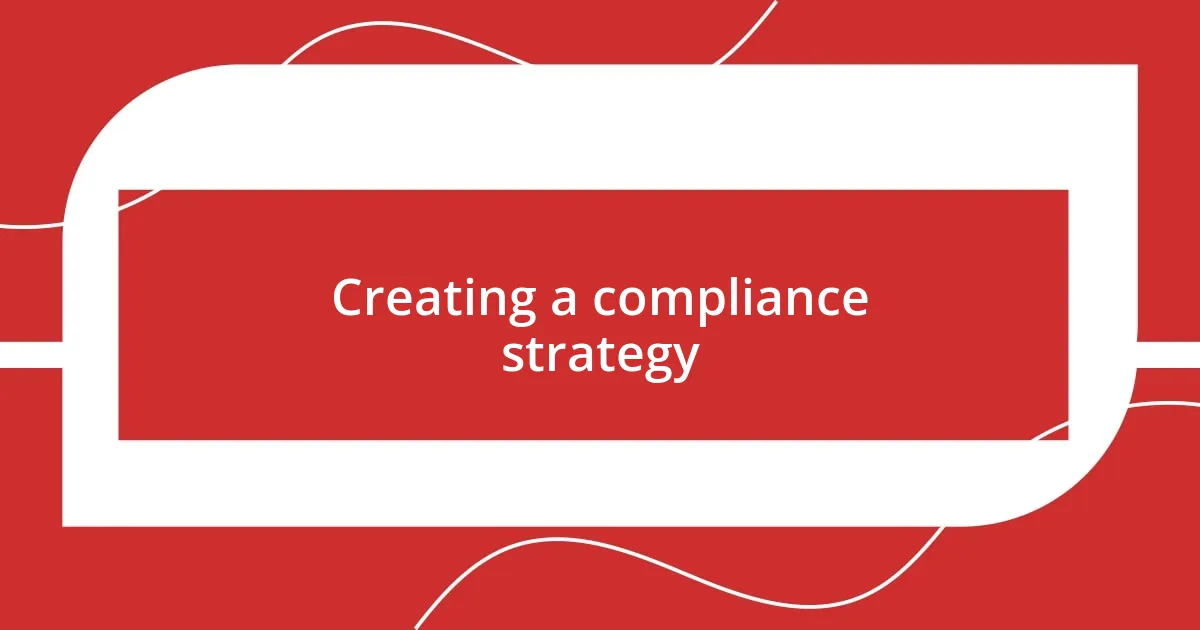Key takeaways:
- Fundraising compliance is essential for protecting an organization’s legal standing, building trust with donors, and maintaining credibility.
- Developing a proactive compliance strategy and using tools like calendars and shared digital folders enhances organization and reduces stress.
- Continuous review and adaptation of compliance procedures, involving team feedback, is crucial for staying up-to-date and ensuring understanding.
- Open communication within the team fosters a culture of transparency, allowing for the early identification and management of potential risks.

Understanding fundraising compliance
Understanding fundraising compliance is crucial for any organization looking to raise funds responsibly and ethically. From my experience, navigating through the myriad of regulations can feel like wandering through a maze. Have you ever felt overwhelmed by the sheer volume of rules? I certainly have, especially when I first started. Each state has its own rules, and understanding the nuances makes all the difference to avoid pitfalls.
I remember one fundraising campaign where I encountered unexpected compliance hurdles. We had planned an exciting event, only to realize we hadn’t secured the necessary permits. The tension in the room was palpable as we scrambled to fix the situation. It was a stark reminder that neglecting compliance not only jeopardizes funds but can also damage your organization’s reputation. This experience emphasized to me that staying informed is not just a legal obligation but a fundamental part of building trust with our supporters.
Furthermore, the emotional weight of fundraising compliance can’t be underestimated. Knowing that every step we take is under scrutiny adds a layer of pressure that can be daunting. Yet, when I learned to view compliance as a protective measure for our mission, it shifted my mindset. Isn’t it comforting to know that these standards exist to safeguard not only our organization but also the donors’ intent? Understanding this aspect truly helped me embrace compliance as an ally rather than an adversary.

Importance of compliance in fundraising
It’s easy to overlook compliance when you’re wrapped up in the excitement of fundraising. Yet, I quickly learned its significance after a well-planned campaign hit a snag because of missing disclosures. My heart sank when I realized we risked losing not just funds but the confidence of our supporters. Compliance serves as a foundation for our fundraising efforts, ensuring we operate transparently and ethically. It reassured me that our mission is sound, and it protects the trust we’ve built with our community.
Here’s why compliance is essential in fundraising:
- Legal Protection: Adhering to regulations shields your organization from potential legal issues, safeguarding your resources.
- Trust Building: By following the rules, you show your donors that you value their contributions, fostering a loyal supporter base.
- Reputation Management: Staying compliant enhances your organization’s credibility, mitigating the risk of negative publicity or damage to your brand.
When I experienced the fallout from a compliance mishap, it hit home how crucial these elements are. The emotional toll of uncertainty was exhausting, but in retrospect, the learning curve has made me a better leader. After all, protecting our mission and maintaining integrity is what fundraising is all about.

Identifying relevant regulations and laws
Identifying the relevant regulations and laws governing fundraising can be overwhelming. In my early days, I remember spending countless hours poring over documentation, trying to determine which state laws applied to our fundraising efforts. Each state has different requirements, such as registration, disclosure, and reporting standards. Have you ever felt like you were trying to learn a new language? I found that reaching out to local regulatory bodies made a world of difference in clarifying what we needed to know.
Moreover, I’ve learned that understanding federal laws, like the IRS regulations for nonprofits, is just as crucial. For example, there’s nothing more frustrating than finding out too late that you missed a crucial filing deadline. Once, I nearly overlooked a requirement for our tax-exempt status, and it gave me quite a scare. The reality is that staying informed about both state and federal regulations isn’t just a best practice; it’s essential for the sustainability of our organization.
Lastly, the online resources available today can be incredibly helpful but also quite overwhelming. Websites like the National Association of State Charity Officials provide a wealth of information, yet I found it best to combine that with local consultation. Have you tried navigating these resources? It’s best to engage directly with someone knowledgeable, as it can offer insights that help tailor your approach to fundraising compliance effectively.
| Aspect | State Regulations | Federal Regulations |
|---|---|---|
| Requirements | Varies by state | IRS compliance standards |
| Registration | May need to register before soliciting | May require 501(c)(3) status |
| Reporting | Annual reports required | Form 990 filing |

Creating a compliance strategy
Creating a compliance strategy is like building a safety net for your fundraising initiatives. I distinctly remember sitting down with my team and brainstorming what we needed to safeguard our campaign. We mapped out key compliance components, such as deadlines for filings and the necessary documentation. This discussion not only clarified our obligations but also fostered a sense of accountability among us. Have you ever experienced that moment when everything just clicks? I know I did.
As I dived deeper into our compliance strategy, I realized the importance of continuous learning. Regulations can shift, and what worked last year might not be applicable now. I set reminders for regular training sessions and encouraged open dialogue among my team. It felt empowering to share knowledge and updates, knowing that each one of us played a role in maintaining compliance. I often ask myself: how can we make compliance less daunting and more ingrained in our culture? The answer is simpler than expected—creating an environment where compliance becomes part of our daily routine, rather than a checklist item.
Using tools to monitor compliance became my favorite part of the process. Implementing a project management tool allowed us to visualize our deadlines and tasks clearly. I remember the relief I felt when I could see in real-time what needed attention and when. As our confidence grew, so did our ability to fundraise effectively. What I found was that a solid compliance strategy not only safeguards your efforts but also enhances your overall fundraising experience. Just imagine the peace of mind that comes from knowing you’re operating above board and with integrity!

Best practices for maintaining compliance
Maintaining compliance can feel like a juggling act, but I’ve discovered a few key practices that ensure I stay on top of things. One method that has worked well for me is creating a compliance calendar. This calendar outlines important filing dates and reminders for any necessary updates. I remember when I missed a key reporting deadline—it was stressful, to say the least! Now, I can’t imagine working without this calendar; it’s like having a personal assistant.
Regular team meetings have also become an invaluable tool. I’ve found that discussing compliance openly keeps everyone informed and engaged. We’ve turned these discussions into a space where each person can share insights, ask questions, and even express concerns. Have you ever walked away from a meeting feeling more connected and empowered? That’s exactly what happens when we collaborate on compliance. It’s not just about checking boxes; it’s about creating a culture of transparency and accountability.
Finally, I’ve learned the importance of keeping documentation organized and accessible. I created a shared digital folder for all compliance-related documents, which has saved us so much time and hassle. The first time I needed to retrieve important records during an audit, I realized just how valuable this practice was! It’s a simple step, yet it can make a significant difference in stress levels and efficiency. Do you know the feeling when everything is in its place? It definitely makes navigating compliance a smoother journey.

Managing risks and challenges
Managing risks in fundraising compliance is a constant balancing act, and I’ve faced my fair share of challenges. One particularly stressful moment came when a last-minute legal change threatened to derail our campaign. I remember the sense of urgency we felt as we scrambled to assess our compliance against the new requirements. It was in that moment of chaos that I realized the true value of having a proactive risk management plan. How comforting it is to know that you can navigate uncertainty armed with prior insights and strategies!
As I delved deeper into the nuances of compliance, I realized that communication is crucial. I made it a point to foster an environment where team members felt comfortable sharing concerns about compliance risks. There was one time when a colleague noticed a potential conflict of interest in one of our fundraising partners. Instead of brushing it aside, we discussed it openly, which not only resolved the issue but also strengthened our team’s trust. Have you ever uncovered a potential risk through candid conversation? Those moments reinforce the importance of teamwork in managing challenges.
I’ve also learned that flexibility is key when dealing with risks. In one campaign, we faced unexpected hurdles that required us to pivot our approach entirely. I recall feeling apprehensive yet exhilarated as we devised a quick alternative plan. It’s fascinating how adaptability transformed our challenge into an opportunity for innovation. Do you feel that way too when you’re pushed outside of your comfort zone? Embracing these situations has taught me that managing compliance is about resilience and ongoing improvement, allowing us to turn potential setbacks into stepping stones.

Reviewing and updating compliance procedures
Reviewing and updating compliance procedures is not just a routine task; it’s a vital practice that can keep your organization ahead of potential pitfalls. I remember a time when I discovered outdated procedures in our compliance manual. It was troubling to realize that we were almost 12 months behind on some key regulations. That moment pushed me to establish a regular review cycle, where we now meet quarterly to dissect and update our processes. It’s amazing how often we find small adjustments that can lead to significant improvements in our compliance posture.
In my experience, engaging with stakeholders during these reviews has been invaluable. I initiated feedback sessions where team members who work directly with compliance share their perspectives. During one of these sessions, a junior staffer pointed out some confusing language in our procedures. It made me realize how critical it is to ensure that everyone understands the rules they’re working within. Have you ever found clarity in unexpected suggestions? Those moments have enriched our compliance framework and cultivated a more inclusive environment.
Lastly, I believe in the power of documentation to reinforce changes. After updating our procedures, I created one-page summaries to distribute among the team. The reaction was overwhelmingly positive—people appreciated having a quick reference guide they could reference easily. This little change made compliance feel less daunting. Doesn’t it feel good when the information you need is just a glance away? Streamlining access to updated procedures has genuinely transformed how we approach compliance as a team, boosting confidence and promoting responsibility across the board.















